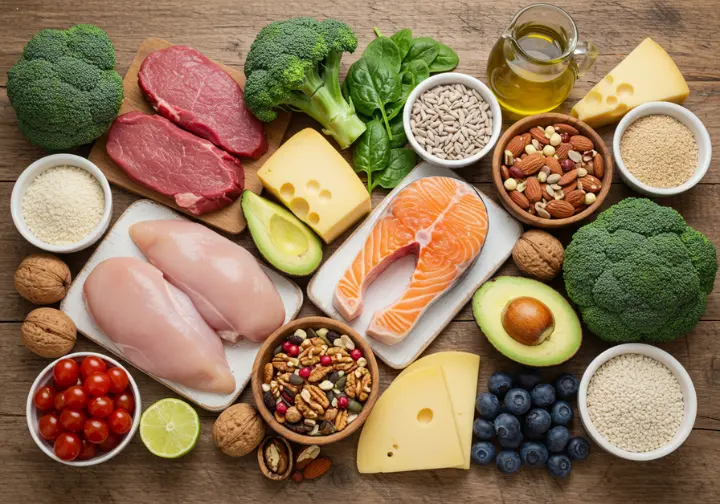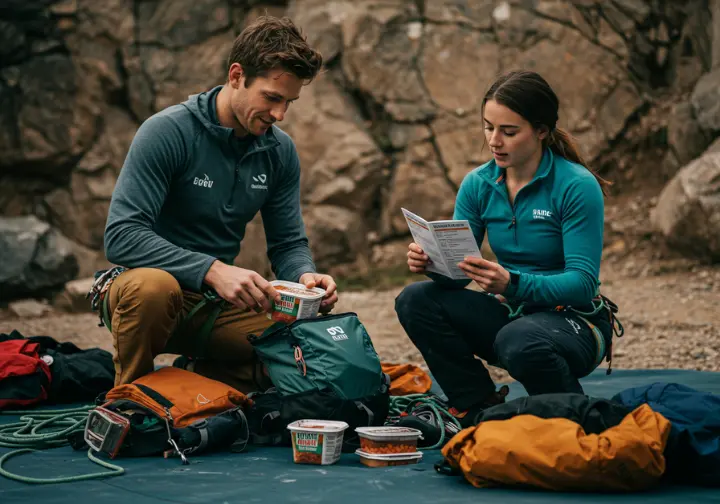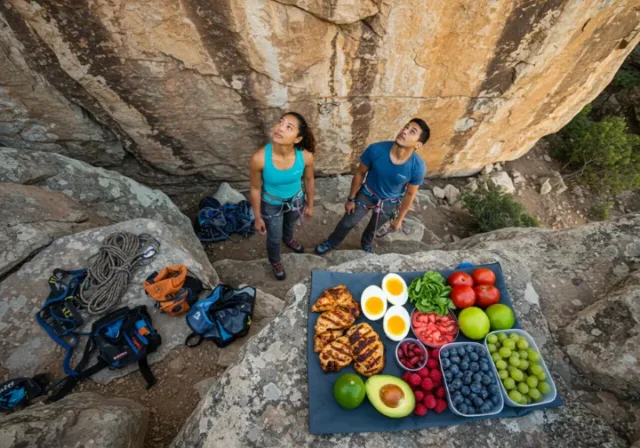In this article
In the relentless battle against gravity, every climber seeks a performance edge. We constantly refine our technique, build our strength, and push our endurance. A primary motivator for exploring specific nutritional strategies is the optimization of the strength-to-weight ratio. This has led to a growing curiosity within the climbing community about high protein, low-carb (HPLC) diets. This article aims to be a definitive guide to these low carb, high fat diets, sorting fact from fiction. We will provide a comprehensive list of high fat high protein low carb foods suitable for climbers. We’ll also delve into meal strategies, the science behind the diet, and a critical look at the potential benefits versus the significant performance risks.
Decoding High-Protein, Low-Carb (HPLC) Diets

To properly evaluate an HPLC dietary plan, we must first break down its fundamental principles. By defining the specific macronutrient ratios, explaining the metabolic state of ketosis, and clarifying the practical concept of “net carbs,” you can begin to make informed decisions about whether this approach, similar in ways to the Atkins diet, is right for you.
The Science Behind HPLC Macronutrient Ratios
A high-protein diet is marked by a major shift in macronutrient intake, prioritizing dietary protein while restricting carbohydrates. Low-carbohydrate diets generally define a low-carbohydrate intake as constituting less than 26% of total daily calories, with protein often targeted at 30% or more. This stands in stark contrast to standard athletic dietary patterns, which might recommend 60-65% of calories from refined carbohydrates.
The core principle for climbers is the potential to favorably alter body composition. Reducing calories from carbs means you must increase fat and protein intake to meet energy demands. Climbers adopt this strategy hoping to reduce non-functional body mass like fat tissue while preserving the muscle that generates power.
It’s useful to differentiate a general HPLC approach from strict ketogenic diets. While both limit carbs, a keto-friendly diet is far more restrictive, often limiting carbs to under 50 grams per day. It also emphasizes a very high-fat intake, around 70-75%, to specifically induce a state of ketosis. An HPLC diet can offer more flexibility, potentially making it a more adaptable strategy. You can find more general guidelines for macronutrient ratios to better understand these principles.
Understanding Ketosis: Fat as a Primary Fuel
Ketosis is a metabolic state that occurs when the body, deprived of its usual fuel source (glucose from carbs), switches to burning its fat stores for energy. This metabolic shift is triggered by severely restricting carbohydrate consumption. This process lowers insulin levels, signaling the liver to produce ketone bodies from fatty acids. These ketones then serve as an alternative fuel for the body and brain.
To enter and maintain ketosis, as seen in a standard ketogenic diet (SKD), specific macronutrient ratios are required. This typically involves getting 70-75% of calories from fat, 15-20% from protein, and only 5-10% from carbohydrates. This physiological shift is the basis for many of the diet’s purported effects and is central to the conversation about integrating the ketogenic diet with exercise.
This state is theoretically appealing to climbers. The concept of tapping into the body’s vast fat deposits for sustained energy seems beneficial for long endurance routes. It might also help in achieving the very low body fat percentages (6-12% for men, 10-18% for women) often seen in elite climbers, improving that critical strength-to-weight ratio.
Calculating “Net Carbs” for Dietary Success
“Net carbs” is a crucial calculation for anyone on a carb-restricted diet. This term refers to the carbohydrates that are actually digested by the body and have an impact on blood sugar levels. For a simple calculation for net carbs, you can use the standard formula: Total Carbohydrates – Fiber – Sugar Alcohols = Net Carbs.
The rationale for this is straightforward. The human body can’t fully break down fiber, so it has a minimal effect on blood glucose. Similarly, certain sugar alcohols like erythritol are only partially absorbed, which lessens their impact, though this can vary. Are you currently tracking your macros to meet your dietary targets?
Understanding this concept is practically important for the diet’s sustainability. It allows climbers to include nutrient-rich foods like avocados and non-starchy vegetables, which might otherwise be avoided if looking only at total carbs eaten. This makes the diet more varied. For anyone following very low-carb plans, calculating net carbs is crucial.
The Ultimate High Fat High Protein Low Carb Foods List

Now that the science is clear, we can move to practical application. Here, we deliver on our main promise with a detailed, categorized list of foods that fit the HPLC framework. We’ll cover everything from animal-based and plant-based proteins to the best vegetables, fruits, and fats for a climber.
Animal-Based Protein Powerhouses
Lean proteins from animal-based foods are a cornerstone of an HPLC diet. Key examples include chicken breast, which provides approximately 26 grams of protein per 4-ounce serving, pork tenderloin, and lean beef cuts like top round. These are excellent dietary protein sources, essential for the muscle repair and growth that climbers need after strenuous training sessions.
Fatty fish and other seafood offer high protein and additional benefits. A comprehensive list includes salmon (rich in omega-3 fatty acids), halibut, and shrimp. Canned foods like tuna are a convenient protein source. These options contain 20-29g of protein per serving, and the anti-inflammatory benefits of a good fat intake can aid in recovery.
Eggs and dairy foods are also fantastic options. A large egg is a versatile and complete protein source, offering about 6 grams of bioavailable protein. For dairy, focus on low-carb, high-protein options like plain Greek yogurt, cottage cheese, and hard cheeses. It’s vital to choose unsweetened versions to avoid hidden sugars. For more ideas, you can review lists of Top High-Protein, Low-Carb Foods.
Plant-Based and Vegetarian High Protein Low Carb Foods
For those following plant-based diets, soy products are excellent choices because they are complete proteins. This includes tofu, tempeh (a protein-dense 20g/4oz), edamame, and unsweetened soy milk. These plant-based protein sources provide a solid foundation for any vegetarian or vegan climber on a low-carb diet.
Seitan is an exceptionally high-protein option for vegans (21g/oz), but it comes with a clear warning for those with gluten intolerance. Most beans are too high in carbs for this diet, but there are exceptions. Specific low-carbohydrate legumes like Lupini Beans (26g protein/cup) and Black Soybeans are suitable.
Vegan protein powders, such as a protein powder isolate from pea, rice, or hemp, offer a convenient way to supplement protein needs. This is critical for vegan climbers to ensure they get a complete amino acid profile. Obtaining sufficient lysine can be challenging on a plant-based, low-carb diet without using protein supplements. You can find many other High-Protein, Low-Carb Vegetarian Foods to add variety.
Essential Vegetables, Fruits, and Healthy Fats
On an HPLC diet, non-starchy vegetables should form the bulk of your minimal carbohydrate intake. Key examples of these low-carb vegetables include spinach, kale, broccoli, cauliflower, and zucchini. These vegetables are vital for providing the fiber and important nutrients needed to support overall health.
Most fruits must be avoided due to high sugar content, but some can be included in moderation. Berries are recommended for their antioxidant content and relatively low carb count. Avocado stands out as an excellent source of healthy fat and fiber with very few net carbs, making it a staple. You can find its nutrition facts on most tracking apps.
On a low-carb diet, fat becomes a primary energy source and is crucial for satiety. Excellent sources include olive oil, avocado oil, nuts, and seeds. Climbers should prioritize unprocessed, whole foods to get these healthful fats. For those new to this way of eating, A Detailed Beginner’s Guide to Keto can provide a solid foundation.
Strategic HPLC Eating for Climbing Performance

Knowing what to eat is only half the battle; knowing how and when to eat is just as important for performance. We now move from a simple food list to actionable strategies, providing sample meal choices and discussing the critical topic of nutrient timing for your climbs.
Meal and Snack Ideas for Climbers
To start the day with sustained energy, a high protein meal is key. HPLC-compliant breakfasts should focus on protein and fat. Examples include a spinach and feta omelet with avocado, scrambled tofu with low-carb vegetables, or plain full-fat Greek yogurt with nuts and a few berries as a high-protein topping.
For lunch and dinner, there are many satisfying meal choices. Consider a large salad with grilled tempeh, or tuna salad made with avocado mayo in lettuce cups. Baked salmon with roasted asparagus, or bunless turkey burgers with a side salad are also great keto-friendly meals. There are many Budget Friendly Low Carb Recipes available.
A long day at the crag requires a practical, low-carb snack. Hard-boiled eggs, low-sugar beef jerky, almonds, and string cheese are all excellent choices. A useful snack is a single-serving pouch of tuna or canned salmon. This provides a direct solution to a common challenge. Even small comforts like insulated bottles can make a day of crag snacking more enjoyable.
Nutrient Timing: Pre-, During-, and Post-Climb
The HPLC approach to pre-climb nutrition diverges significantly from traditional sports nutrition. Instead of carb-loading with whole grain carbs, the focus is on protein and fats for sustained energy. This presents a challenge for fueling high-intensity sessions where quick energy from carbohydrates is needed.
Fueling during a long or intense climb is difficult on a strict HPLC plan. Standard advice suggests 30-60g of carbs per hour. HPLC options are limited to slower-releasing energy from nuts or jerky, which may not be sufficient. This is a key consideration when transitioning from indoor climbing gyms to outdoor sport climbing, where energy demands can be less predictable.
Post-climb, a low carbohydrate meal aligns well with the body’s need for high protein intake to repair muscle. Your total protein intake after a climb is key for recovery. A meal rich in protein, like grilled salmon, helps maximize adaptation. When planning your nutrition, reviewing a Climbing Nutrition Guideline From Amity Warme is helpful.
The Climber’s Crux: Risks and Performance Controversies

No dietary strategy comes without potential downsides, and for climbers, the performance stakes are high. It’s time for a balanced and cautionary look at the significant risks and debates surrounding commercial diets like these. We’ll address the impact on high-intensity performance, side effects, and long-term health concerns.
The High-Intensity Performance Debate
Herein lies the central conflict: while HPLC diets may improve fat oxidation and lead to fat loss, evidence suggests they can compromise high-intensity exercise. This performance is fundamental to bouldering and sport climbing. Carb-rich foods are a more efficient fuel source for the short, powerful, anaerobic movements that define a climb’s crux.
Many nutrition experts express skepticism about low-carb diets for power athletes. The body preferentially uses glucose from healthful carbohydrates for intense efforts. Prolonged adherence to a low-carb diet can even reduce the muscles’ ability to utilize carbohydrates effectively, hindering performance. This is a critical factor for athletes focused on breaking performance barriers.
Another consideration is increased “perceived exertion.” Research has shown that low-carb diets can make exercise feel harder. This can lead to earlier fatigue and a reduction in training quality or performance. A Systematic Review of the Effects of low-carb diets on exercise can provide deeper insight into this debate.
Adaptation Phase and Potential Health Risks
During the initial adaptation phase to an extreme diet low in carbohydrates, many experience the “keto flu.” Symptoms can include fatigue, headaches, irritability, and digestive issues. This period can significantly disrupt a climber’s training consistency and well-being.
There are potential long-term health considerations. Restricting food groups can lead to an inadequate intake of vitamins and minerals. With some fat diets, there are debated risks like fatty liver disease or increased acid load on the kidneys. For a balanced view, it helps to weigh the Pros and Cons of the Keto Diet.
Other debated health implications include conflicting information regarding bone density and potential alterations to the gut microbiome from a lack of fermented foods. Some research has linked animal-based low-carb diets to a higher mortality risk, underscoring the importance of sourcing quality proteins. Addressing these risks is part of preventing injuries.
Advanced Strategies: Carb Cycling and TKD
For climbers intrigued by low-carb benefits but wary of the risks, carb cycling presents a more balanced diet. This strategy involves alternating between low-carb days and higher-carb days. This allows a climber to reap some metabolic benefits without sacrificing fuel for their most demanding efforts.
A Targeted Ketogenic Diet (TKD) is another modification. An athlete on a TKD maintains a ketogenic state but strategically consumes 20-50g of easily digestible carbs 30-60 minutes before an intense workout. This method directly attempts to solve the performance problem seen with a strict carbohydrate limit.
Ultimately, there is no one-size-fits-all diet. It is paramount to listen to your body before making dietary changes. We strongly recommend consulting a registered dietitian, ideally a sports specialist, before undertaking such restrictive dietary patterns to ensure safety and nutritional adequacy.
Key Takeaways for a Climber’s Nutrition
The central conflict for climbers is clear: while HPLC diets can be effective for changing body composition, this benefit may come at the cost of high-intensity performance. The trade-off between a better strength-to-weight ratio and compromised power must be carefully considered by each individual athlete.
The “best” diet is one that is sustainable, supports health, and aligns with your specific climbing goals. Rigidly following a dietary dogma is often less effective than an informed, personalized strategy that adapts to your needs and performance feedback. A balanced diet of whole foods is often the most sustainable choice.
Remember that less restrictive alternatives exist. Strategies like carb cycling or a Targeted Ketogenic Diet (TKD) offer potential compromises. They may provide some benefits of lower-carb eating without completely sacrificing the fuel needed for powerful moves. For many climbers, a balanced approach will be more beneficial in the long run.
Finally, we strongly recommend seeking advice from qualified professionals. Consulting a dietitian can help you navigate the complexities of sports nutrition, minimize risks, and ensure that any dietary changes support, rather than hinder, your long-term health and your lifelong passion for climbing.
Frequently Asked Questions about High Protein Low Carb Diets for Climbing
Can I build muscle on a high-protein, low-carb diet? +
What is the biggest mistake climbers make when trying an HPLC or keto diet? +
Are there any high-protein, low-carb snacks I can easily take on a multi-pitch climb? +
How long does it take to adapt to a low-carb diet for athletic performance? +
We are a participant in the Amazon Services LLC Associates Program, an affiliate advertising program designed to provide a means for sites to earn advertising fees by advertising and linking to Amazon.com. As an Amazon Associate I earn from qualifying purchases. We also participate in other affiliate programs. The information provided on this website is provided for entertainment purposes only. We make no representations or warranties of any kind, expressed or implied, about the completeness, accuracy, adequacy, legality, usefulness, reliability, suitability, or availability of the information, or about anything else. Any reliance you place on the information is therefore strictly at your own risk. Additional terms are found in the terms of service.











